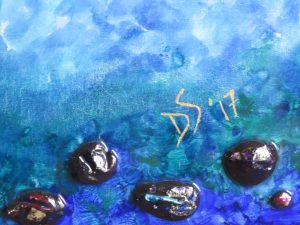Getting Ready to Be Artistic
Category : Arts
 As an artist, I am sometimes asked about how I get started, create my creative environment or even just ‘getting stuff done’ and be artistic. Here are my thoughts and shares on the subject:
As an artist, I am sometimes asked about how I get started, create my creative environment or even just ‘getting stuff done’ and be artistic. Here are my thoughts and shares on the subject:
Getting Organised and Be Artistic
The where
I used to have a ‘studio’ … essentially a room which had great light and was all set up … and this is where I worked. Since moving house, I have adapted my workplace. I still have a space as such where I have all my ‘tools’ but the light isn’t so great, so a little different, I stand when painting. I prefer to stand and as I’m often painting larger pieces, I use the ‘island’ in my kitchen which is a decent sized space and excellent lighting. Hey, to me it’s not a problem as I’m a ‘neat’ painter (there isn’t a lot of splatter or mess and it all wipes off the surface very easily). Yes, sometimes I do venture outside and of course for the resin finish, I move to my garage. What I love about using the kitchen is easy access to water, whilst still being close to my ‘tools’.
The when (and yes, finding the time)
As a business coach, my advice will have two different directions:
Hobbyist – if you paint for the joy of it and almost as a hobby, then do it when you’re feeling inspired and don’t set a time. Don’t stress if you don’t paint for several weeks and then spend several days on task and focussed. If it’s a hobby activity, then enjoy it and don’t worry too much about the whole production activity.
Professional – if you’ve got a deadline or are a professional painter and know if you don’t produce, then you don’t sell and then you potentially don’t have an income, then it’s a different situation. So, in this scenario, you don’t have the luxury so much of doing it when you feel inspired. Check out my upcoming article “Making the Time to be Artistic”.
Setting the mood
Every person is different. For some it’s grabbing a coffee, ensuring lighting is at maximum and simply starting. For others, you may wish to burn aromatherapy oils, put on some great music and ‘set the mood’. For me personally, it’s lights, music and action.
Your tools
May I say first, have your gear organised. Keep everything in one place, and if you’re running low on a product or colour, be sure to add it promptly to your ‘shopping list’. Nothing worse than being in creative mode 8am on a Sunday and you run out of a colour. Also, of course, look after your tools especially your brushes. Some of these can be really expensive so be sure to keep them in water and clean immediately after use. I find (water-based) that water with a little soap (and then a clean rinse) works really well.
For me, I have a ‘shopping’ app on my phone and I have a tab for art supplies … where I note any stock I’m running low on. Then when I place a stock order or visit my supplier I have a list of everything and am efficient in my purchases.
One piece at a time?
With my style, being mixed media, I have to allow for dry times between ‘layers’ and components. For this reason, I tend to paint 2 or 3 pieces at once. When I’m in paint mode, this allows me to continue to work, whilst something is drying. (A hair dryer on watercolours has an interesting effect but it may not be the results you’re looking for!) What you do need to be cautious of is that if you have too many pieces started but never get to finish anything, then as an artist (hobbyist or professional) that may not leave you feeling satisfied. If you have a tendency to start many but finish little, then work on that. Set a limit, once you reach that number limit until one item is finished you will not allow yourself to start the next.
The what
I get asked, “how do I come up with ideas?”. Generally, something I see inspires me. Often I am inspired by nature, colour, and even both. Now that I have a decent camera (the mobile phone one just doesn’t work effectively) I am now able to photo things I see in nature (perhaps a jellyfish on the beach, some sunrise clouds, flowers in bloom or an interesting architecture whilst travelling). Invariably, what I see does not translate immediately to the canvas because of my style being somewhat abstract. Instead, often I will take the photo or capture an image and then pencil sketch a concept in draft form.
How do I know what will work?
Whilst I’ve had formal training (many, many moons ago), I often think I have an eye for both colour, balance and what looks right. However, sometimes I might be unsure of colours, so in my draft sketches I may even use coloured pencils in my draft. At times too, I will even paint a small version to ‘test’ the concept, particularly when I am planning to use a large (and sometimes expensive) canvas. As I work partially with watercolours, there is often little room for ‘error’ or for fixing things, so I need to be fairly confident with what I am doing.
What about ‘anomalies’?
Sometimes the most beautiful, wonderful, creative and extraordinary results occur by ‘accident’. I love to experiment and try things and be creative, which means sometimes the unexpected occurs … which often is incredible. My advice; don’t try to be a perfectionist, allow yourself to ‘play’ and enjoy what you are doing, and ‘go with the flow’.
So, I hope my sharing these things has helped in some way and all the best with your creative pursuits!
